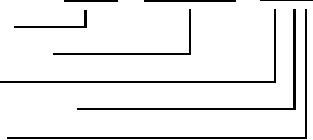
identification numbers, or the name-title symbols, to
5212.1 A
INSTRUCTION
SECNAV
be used are determined by the volume of written matter
in each category to be filed. There may be no need to
Originator
establish folders on some major series groups, while
Type of directive
others may require several folders broken down to
Subject
primary, secondary, or tertiary numbers. The subject
identification numbers or name-title symbols should
Consecutive number
be printed on each folder.
Revision
SKf01014
The subject identification number placed on the
correspondence by the originator assists in
Figure 1-14.--Example of an identifying symbol assigned to
determining the correct folder in which to file the
an instruction.
correspondence. This number, however, may not be
appropriate for the particular office concerned, thereby
requiring reclassifying. The proper method of
Name-Title Subject Identification Codes
classifying a document for the purpose of selecting the
appropriate file is to read it carefully and analyze it,
Name-title codes (alphabetic or alphanumeric
considering the following factors:
codes) are provided for names and titles frequently
used by the Department of the Navy. These codes may
be used for classifying and filing documents by name
1. The most important, definite, or concrete
or organizational designation except that they are not
subject mentioned.
to be used in assigning subject numbers to directives.
2. The purpose or general significance of the
Included are symbols for fleet organizations, the
document.
United States Government, foreign governments,
3. The manner in which users of the files request
c o m m e r c i a l e n t e r p r i s e s a n d fi r m s ; c l a s s e s o f
similar documents.
personnel; types of naval activities; and official
symbols for classes and types of aircraft, vessels, and
4. The subject identification code under which
guided missiles.
previous documents of a similar nature are filed.
The first letter of the name or title code designates
D i r e c t ive s a r e n o t p l a c e d i n t h e g e n e r a l
the larger organizational group, and the second or third
correspondence files except when copies of instruc-
letter designates a further breakdown of the larger
tions and notices are attached to or interfiled in such
group. For example, "NA" designates naval air
files when needed to complete a record or document.
stations. The "N" is for the Naval Shore Establishment
Instructions are filed in standard three-ring binders and
and the "A" for air stations. An Arabic numeral added
are arranged as follows:
to the letter symbol further subdivides the code. For
example: FF--Fleets, Forces, Types, Areas, and Sea
Frontiers. FF1--U.S. Fleet, FF3--U.S. Task Fleets.
1. In numerical order of subject identification
number.
Fleets
2. By the originating office within each subject
identification number.
File arrangement within any office depends upon
the mission of the office and on the volume of its
3. By consecutive number (suffix number) for each
o f f i c i a l c o r r e s p o n d e n c e . N o r m a l l y, g e n e r a l
originating office.
correspondence is stored in metal file cabinets. This
Notices are usually not filed because of their brief
i n c l u d e s l e t t e r a n d m e m o r a n d u m s r e c e ive d o r
duration. Should recipients believe it necessary to file
originated by the office.
a notice temporarily, it may be interfiled with
Folders are used to keep correspondence orderly in
instructions.
the files. Standard file folders are available in two
Messages are filed by the data/time group number.
sizes, letter size (9 x 11-3/4 inches) and legal size (9 x
Normally, two files are maintained with one containing
14-3/4 inches). The total number of folders and the
incoming messages and the other outgoing messages.
appropriate primary, secondary, or tertiary subject
1-32

